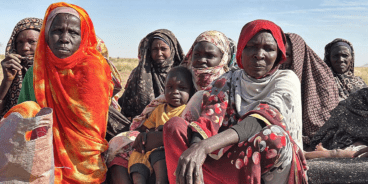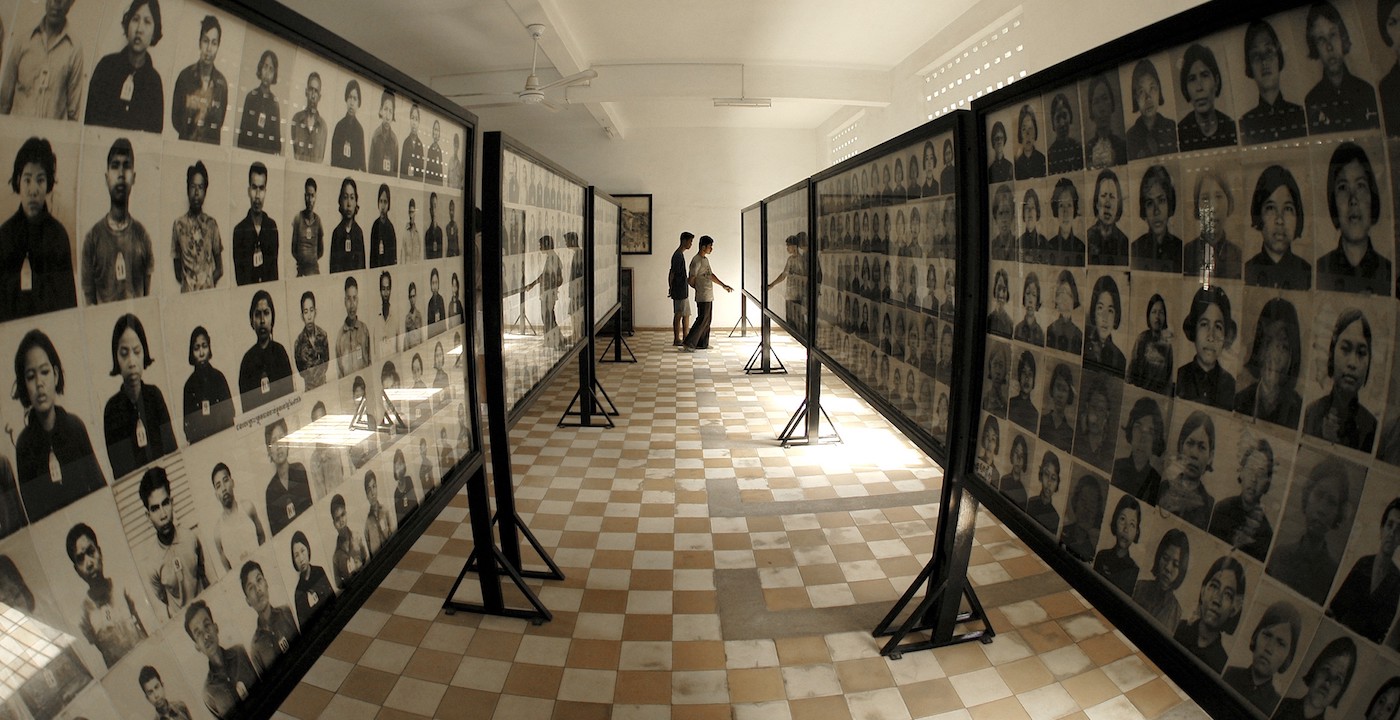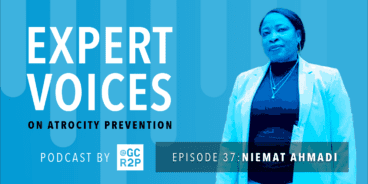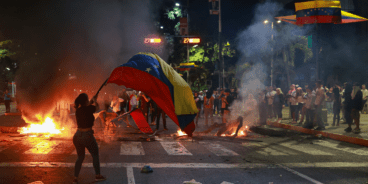

Lessons from the Cambodia Genocide
Speech delivered by Professor the Hon Gareth Evans, Former Foreign Minister of Australia, to a Virtual Public Lecture Event, “The 45th Anniversary of Khmer Rouge Victory: What Lessons Could Cambodia Share?,” co-hosted by the Cambodia Institute for Cooperation and Peace and Asia-Pacific Centre for the Responsibility to Protect, 28 July 2020.
Cambodia stands almost alone in the modern era for the scale and intensity of the suffering its people have endured, above all during Pol Pot’s unbelievably brutal three-year genocidal reign of terror, which began 45 years ago, in 1975, and resulted in the direct killing of hundreds of thousands of Cambodians, and the deaths from malnutrition and disease of many hundreds of thousands more, producing an overall death toll of up to 2 million men, women and children. But before the Khmer Rouge victory, and very much contributing to it, the country was ravaged by massive United States bombing during the Vietnam war; and after Pol Pot was driven out of Phnom Penh by the Vietnamese invasion in 1978, Cambodia was ravaged further by prolonged civil war, which ended only thirteen years later with the Paris Accords and UN transitional presence. And even with the coming of peace in 1993, the country – unhappily – has not been immune from tension, bitterness, major human rights violations and political violence continuing to the present day.
It is right that we continue to focus, on occasions like this, on the events of the mid-1970s and the lessons to be drawn from them. It is right because the horror that Cambodia experienced then, whether or not it be strictly legally definable as “genocide” within the meaning of the Genocide Convention, remains – along with Rwanda and Bosnia in the 1990s – the talismanic Post-World War II case globally of conscience-shocking group violence, be it driven by race, ethnicity, nationality, religion, class, politics or ideology. And for all the progress that has been made in recent years, as an international community we are still, as the events in Syria, Sri Lanka, Myanmar and elsewhere in recent years graphically demonstrate, falling a long way short of being able to confidently say, when it comes to genocide and other mass atrocity crimes, “Never Again.”
In these relatively brief remarks, there are five specific lessons that I want to draw from Cambodia’s experience: don’t assume any country is immune from genocidal violence; don’t assume the world will help; diplomacy can nonetheless make a difference; don’t assume it’s over when it’s over; and don’t give up on the principle of “the responsibility to protect” – R2P – and the hope provided by its unanimous embrace by the UN General Assembly fifteen years ago, in 2005.
Don’t assume any country is immune from genocidal violence
I remember vividly the atmosphere when I first visited Cambodia in 1968, spending a week drinking beer and eating noodles in student hangouts around Phnom Penh, and careering up and down the dusty road to Siem Reap and Angkor Wat in cheap share-taxis, scattering chickens, pigs and children along the way. The country was tranquil, almost then untouched by the war next door in Vietnam, with the massive US carpet bombing still a year away. What happened in Cambodia in the mid-1970s was, before it happened, unimaginable.
But so too was Hitler’s Holocaust utterly unimaginable before it happened – the cold blooded murder of millions of Jews, Gypsies, Slavs, gays and other non-Aryans, not because of anything they did but for what they could not help being – in the land of Goethe, Schiller, Beethoven, Mahler, Weber and many more contributors to some of the great core achievements of Western civilization. The potential for genocidal violence is not confined to fragile developing countries: in an age of authoritarian populism and crude identity politics – think Erdogan, Orban, Bolsonaro, even Trump’s America – the potentially deadly virus of group hatred can emerge almost anywhere in the world.
The truth is – as I well know from years of wrestling with the problem of conflict prevention and early warning when I headed the International Crisis Group – that there is no real science to determining which societies will explode in orgies of deadly conflict and genocidal violence and those which won’t. Relevant factors include historical grievances and enmities; rapid economic, social or political dislocation; arrogant elites prospering amid poverty; poor governance and leadership generally; poor education systems doing nothing to defuse prejudice; and externally generated destabilization (as with the impact of the US bombing campaign in Cambodia, which gave the Khmer Rouge, previously a marginalized guerilla group, a cause and momentum). But there are no one-size fits-all explanations: it’s often the case that countries with similar histories, cultures, and demographics and experiencing similar internal and external pressures, will respond very differently.
Recognizing the myriad of short-term factors – overlaying longer term structural factors – that will influence which way a society will jump, effective conflict and crisis prevention really comes down to avoiding it-can’t-happen-here type complacency; closely monitoring current developments (with the emergence of prevalent hate-speech being an important indicator of the potential for atrocity crimes); being aware of the available toolbox of preventive measures (political and diplomatic, economic and social, legal and constitutional, and security-sector related); and taking whatever remedial action is possible – both internally and externally – before things get out of hand. It’s not clear that any of this would have prevented the Khmer Rouge victory in Cambodia in 1975, but it is the kind of approach which has helped Burundi stop falling into the volcano over the last two decades despite a profile almost identical to its neighbor Rwanda in the mid-1990s.
Don’t assume world help
What was happening in Cambodia in 1975 was known soon enough to the rest of the world – not least as a result of some brave journalists getting the story out from Phnom Penh – but the reaction was overwhelmingly one of stunning indifference. Partly, and this was certainly the case for the Western political leaderships of the time, it was a matter of cynical self-interest, one of the most extreme manifestations of which that has made its way on to the public record being then US Secretary of State Henry Kissinger’s observation to Thai Foreign Minister Chatichai seven months after the Khmer Rouge had marched into Phnom Penh: “Tell the Cambodians that we will be friends with them. They are murderous thugs, but we won’t let that stand in our way.” The whole situation was looked at through a Cold War prism, so much so that when Vietnam’s 1978 invasion did stop the Khmer Rouge mass murder in its tracks, it was not applauded by anyone except the Soviet Union.
The almost universal response, not only in the West but throughout the developing world, was that this was an unacceptable violation of state sovereignty. The notion that sovereignty might yield to a larger responsibility to protect those at risk of genocidal violence – to what Kofi Annan was later to describe as “gross and systematic violations of human rights that offend every precept of our common humanity” – had not yet taken any widespread root. It was particularly contested in the global South, where so many countries were so proud of their recently won sovereign independence, so conscious in many cases of their fragility, and so unwilling to concede that any of their former imperial masters could, even in the case of extreme human rights violations, have any kind of “right of humanitarian intervention” within their borders.
Despite the formal global acceptance since 2005 of R2P, which I will come back to below, the unhappy reality remains to this day that if preventive efforts are non-existent or fail, and genocidal violence does erupt, the international will to take strong measures – including, in the last resort. Security Council endorsed military intervention – is in the current international environment almost as non-existent as it was in 1975. Everything really does depend on effective prevention, and a great deal of that is going to have to come from brave internal actors willing to push back against authoritarian overreach. Few things matter more in protecting human rights than strong civil society organisations, and it is gratifying to see in Cambodia how many decent individuals – many of whose voices are heard in Sue Coffey’s excellent edited collection, Seeking Justice in Cambodia: Human Rights Defenders Speak Out (MUP, 2018) – continue to work bravely and tenaciously in an extremely difficult and often extremely hostile political environment, to achieve just that.
Diplomacy can make a difference
The Khmer Rouge threat did not disappear with the Vietnamese invasion: supported by China, it remained a significant force in the provinces, and large-scale civil war continued to take its toll of Cambodians in terms of death, injury, displacement into cross-border refugee camps, general immiseration and loss of life opportunity. The situation was not helped by the multiplicity of actors who had different stakes in the outcome. Internally there were four warring factions – with Hun Sen’s Government waged against a fragile coalition of the non-communist Sihanoukists and Son Sann’s KPNLF with the communist Khmer Rouge under Pol Pot, and each group immensely distrustful of all the others; regionally, Vietnam supported Hun Sen and the six ASEAN members of the time supported his opponents; and, at the great power level, China supported the Khmer Rouge and Prince Sihanouk (as he then was); the Soviet Union supported Hun Sen; and the United States supported the two non-communist resistance groups.
Untangling all this was a formidably complex and protracted diplomatic process, but one that did eventually bring peace. The key to the successful UN peace plan, which I am proud to say that Australia played a central part in forging, was to find a face-saving way for China to withdraw its political and financial support from the Khmer Rouge, which denied that support would either at best immediately collapse or at worst over time wither and die on the vine. The crucial diplomatic agreement was to give an unprecedentedly central role to the United Nations, not just in peacekeeping or electoral monitoring, but in the actual governance of the country during the transitional period. This did give China the cover it needed to disengage from the Khmer Rouge, which did then effectively collapse as an effective force, making a return to peace at last possible.
Peace-making diplomacy will not always be as successful as it was in Cambodia from 1989-91, with the actors who had contributed so much to the problem cooperating effectively to produce a solution, or – to take another example – Kenya after the December 2007, when catastrophically escalating ethnic-based violence was defused by an African Union and UN supported mission led by Kofi Annan negotiating a power sharing cabinet and setting in train ongoing negotiations on underlying root cause issues.
But such diplomacy will always be worth pursuing, as will earlier stage preventive diplomacy involving measures like fact-finding missions, friends groups, eminent persons commissions, conciliation and mediation, and support for non-official second-track dialogue. The difficulty is always to move from rhetoric to effective action: talk is cheap, and there has for many years been endless amounts of it in and around the UN system about the critical importance of prevention, through diplomacy, development assistance and other strategies. But willingness to make the necessary commitment of time and resources has always been in short supply, and shorter still in the present international environment
It may not be over when it’s over
Peacemaking, if it is to be genuinely successful and sustainable, has to be accompanied by effective post-conflict peacebuilding. The end of the Khmer Rouge genocide and the final destruction of its warfighting capability did bring an end to much of Cambodia’s misery, but not all of it. At the signing of the Paris Peace Agreements in 1991, I said in my statement as Australian Foreign Minister that “Peace and Freedom are not prizes which, once gained, can never be lost. They must be won again each day. Their foundations must be sunk deep into the bedrock of political stability, economic prosperity and above all, the observance of human rights.” Sadly, since 1993, the truth of that observation has been borne out over and again.
A foretaste of things to come came with Hun Sen’s refusal to accept his defeat at the UN supervised election in 1993, insisting on a power-sharing arrangement which the international community did not resist, as in retrospect we certainly should have. Since then there has been systematic suppression of any movement towards a mature democracy, with repression of free speech and assembly, the arrest of many human rights activists who have tried to speak out for fundamental freedoms, and the thwarting of every attempt to have a genuinely free election, with periodic resort to murderous violence. In recent months, the Covid-19 pandemic has been used as cover for the passage of further draconian legislation by a parliament from which opposition members have been excluded, further suppressing freedom of speech and assembly, allowing control of technology by any means necessary, and providing for long jail terms and property confiscation.
History teaches us that perhaps the best single indicator of future conflict, within or between countries, is a record of past conflict. Among the countries most at risk of genocidal violence are those that have been there before. Cambodia is a country demanding constant vigilance, both from its own citizenry and from the international community, if it is to meet the hopes and aspirations – not only for peace, but democracy and human rights – of all those who fought so hard to free it from the yoke of Khmer Rouge tyranny. That task was not completed with the UN peace process three decades ago: it remains work in progress.
Don’t give up on R2P
If we are to end once and for all the occurrence or recurrence of genocide and other mass atrocity crimes happening within sovereign state borders anywhere in the world, it is crucial that the international community seriously commit itself to the effective practical implementation of all the “the responsibility to protect” principles which heads of state and government unanimously endorsed at the 2005 World Summit, finally recognizing how indefensible their failure to act had been in Cambodia, Rwanda, Srebrenica and elsewhere.
It is not just a matter of states recognizing their own responsibility not to perpetrate or allow mass atrocity crimes within their own borders, and to assist other states to so act through aid and other support; it’s also a matter of states taking timely and decisive action to halt such crimes – including in extreme cases through UN Security Council endorsed military intervention – if a state has manifestly failed to do so. The present reality is that, particularly when it comes to that more robust third pillar, R2P remains at best work in progress.
As a normative principle – that mass atrocity crimes perpetrated behind sovereign state borders are not just that state’s but the world’s business – its acceptance, as evidenced by annual General Assembly debates and scores of Security Council resolutions, is almost complete. As an effective preventive force, and as a catalyst for institutional change, it has had many identifiable successes. But as an effective reactive mechanism, when prevention has failed, the record – since the Libyan case ran off the rails in 2011 – has been manifestly poor, above all in Syria. In the present international environment – with China and Russia now behaving as they are – it will be a long and difficult process to recreate any kind of Security Council consensus as to how to react to the hardest of cases.
A lot depends in this respect on the willingness of the United States, United Kingdom and France to acknowledge that they, more than anyone else, were responsible for the breakdown of that consensus by their actions in Libya in 2011 – not by their missteps after Gaddafi was overthrown, which they frankly acknowledge, but their refusal to accept that the military intervention mandate agreed by Security Council, in the face of an imminent massacre in Benghazi, was for limited civilian protection purposes, and did not extend to open-ended warfighting designed to achieve regime change. If Trump is re-elected in the US, we can wave goodbye for the foreseeable future – with R2P as with just about everything else in the multilateral system – to any prospect of effective international consensus on these great value issues. But if he is thrown out in November decency has a chance.
Learning the biggest lesson of all from the Cambodian genocide – the need to make R2P genuinely effective – means above all mobilizing the political will to make something actually happen when it must. For that to happen many arguments need to be effectively made to many different constituencies. But the most compelling argument – the one that spurred world leaders to accept the R2P norm in principle in 2005, and which will continue to be crucial in ensuring its practical implementation – remains the moral one, based simply on our common humanity: our duty to rise above the legacy of all those terrible failures in the past, and ensure that never again do any of us stand by, or pass by, in the face of mass atrocity crimes.
Related Content


Expert Voices on Atrocity Prevention Episode 37: Niemat Ahmadi
